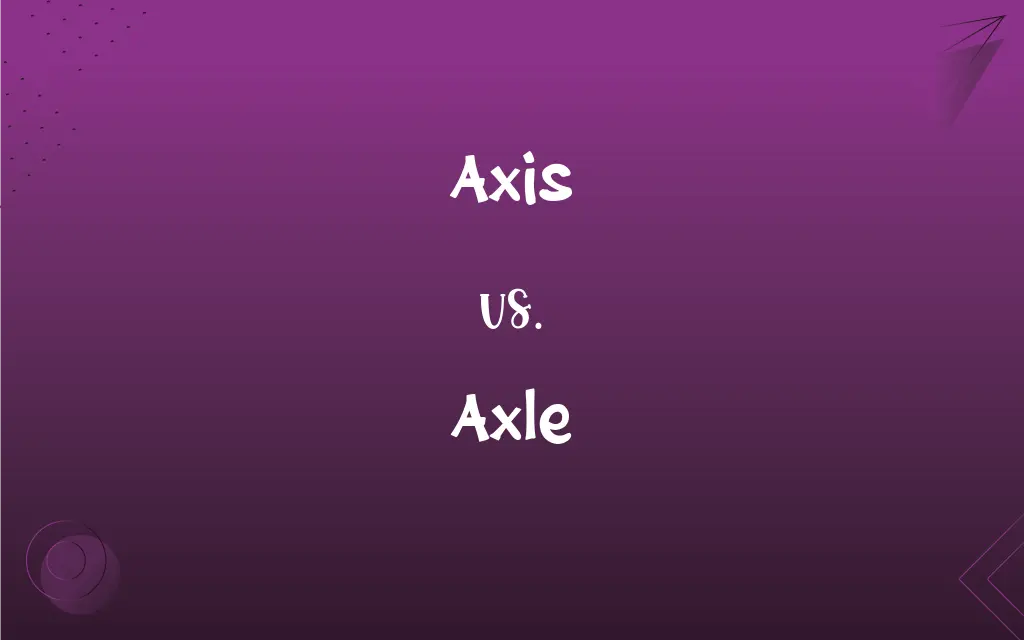Axis vs. Axle: What's the Difference?
Edited by Janet White || By Harlon Moss || Updated on November 2, 2023
Axis refers to an imaginary line about which a body rotates; axle is a physical rod that rotates wheels or gears.

Key Differences
Axis and axle are terms commonly used in mechanics and geometry, but they refer to different concepts. An axis is an imaginary line that something rotates around. For example, the Earth spins around its axis. On the other hand, an axle is a physical rod or spindle that connects wheels or gears, especially in vehicles, enabling them to rotate.
In geometry, an axis is often used to refer to a straight line about which a geometric figure is symmetrically arranged or a standard line to which other parts of a structure or body are referenced. In contrast, an axle is a tangible component critical for the mechanical operation of wheel-based machinery and is not a term used in pure geometry.
While the axis can be considered a central line of symmetry or a pivot point in a system or structure, it does not have to be a component that physically exists; it is often a conceptual guideline. An axle must be a concrete part, typically made of metal, and is central to the functionality of systems like transportation or machinery that require rotation.
An axis is intrinsic to understanding rotational motion and is applied to various scales, from subatomic particles to celestial bodies. Axles, however, are specifically about facilitating movement in vehicles or equipment, suggesting a much narrower application primarily in engineering and mechanics.
One can speak of the axis of a planet, the axis of symmetry, or even a conceptual axis in discussions or illustrations. Axle, however, will always refer to a physical component that needs to be manufactured, maintained, and which has a direct physical role in the operation of a rotating system.
ADVERTISEMENT
Comparison Chart
Definition
Imaginary line for rotation or symmetry
Physical rod allowing wheel rotation
Contexts Used
Geometry, physics, astronomy
Mechanical engineering, transportation
Physical Existence
Conceptual, not tangible
Tangible, must be physically present
Scale of Application
Atomic to cosmic scale
Typically limited to machinery scale
Association
Symmetry, rotation, pivot
Movement, mechanical function
ADVERTISEMENT
Axis and Axle Definitions
Axis
A central or principal structure, around which something turns or is arranged.
The spinal axis is crucial to human anatomy.
Axle
A central shaft for a rotating wheel or gear.
Without a functioning axle, the gears of the clock won't turn.
Axis
A fixed reference line for the measurement of coordinates.
The x-axis and y-axis are foundational in Cartesian coordinate systems.
Axle
A bar or shaft on which a wheel turns.
He applied grease to the axle to ensure a smooth ride.
Axis
A straight line about which a body rotates.
The Earth rotates on its axis once every 24 hours.
Axle
The supporting shaft or member on which or by means of which a wheel or pair of wheels rotates.
The car was hoisted up to repair its rear axle.
Axis
An alliance or partnership.
During World War II, Germany, Italy, and Japan were known as the Axis powers.
Axle
A rod or spindle passing through the center of a wheel or group of wheels.
The truck's broken axle left it immobilized by the side of the road.
Axis
A line of symmetry in a geometric shape.
The diameter of a circle is an axis of symmetry.
Axle
A transverse rod that connects wheels on opposite sides of a vehicle.
A sturdy axle is essential for a vehicle's safety and performance.
Axis
A straight line about which a body or geometric object rotates or may be conceived to rotate.
Axle
A supporting shaft or member on or with which a wheel or a set of wheels revolves.
Axis
An unlimited line, half-line, or line segment serving to orient a space or a geometric object, especially a line about which the object is symmetric.
Axle
The spindle of an axletree.
FAQs
Do all vehicles have axles?
Most wheeled vehicles have axles, which are essential for the wheels to rotate.
Is axis used in scientific contexts?
Yes, it's used in astronomy, physics, and geometry.
Can the term axis refer to something physical?
It's typically used to describe a conceptual line, not a physical object.
What is an axle?
An axle is a physical shaft that connects wheels in a vehicle or system.
Can an axle be seen?
Yes, it is a tangible part of a vehicle or machine.
Does an axis have to be straight?
Typically, yes, it is a straight line by definition.
What's the plural of axis?
Axes.
What is an axis?
An axis is an imaginary line that indicates the center around which an object rotates.
Are axles important in transportation?
Absolutely, they are critical for the function of most vehicles.
Can axis refer to an alliance?
Yes, historically it has been used to refer to political alliances.
Can you provide an example of an axis in nature?
A planet’s rotational axis.
Can you provide an example of an axle in nature?
Natural systems don’t have axles; they are man-made.
Does the strength of an axle matter?
Yes, it must be strong enough to support the vehicle and any load it carries.
Can axles bend?
They can bend under stress, which is usually undesirable.
Are axes important in mathematics?
Yes, they are fundamental in graphing and geometry.
What's the plural of axle?
Axles.
Does an axle have any non-mechanical uses?
Not typically; its uses are mainly in mechanical contexts.
Is the term axis used in 3D modeling?
Yes, it's essential for understanding and creating 3D models.
Is axle used in scientific contexts?
Yes, particularly in physics and mechanical engineering.
Can an axis be seen?
No, an axis is an imaginary line and cannot be physically observed.
About Author
Written by
Harlon MossHarlon is a seasoned quality moderator and accomplished content writer for Difference Wiki. An alumnus of the prestigious University of California, he earned his degree in Computer Science. Leveraging his academic background, Harlon brings a meticulous and informed perspective to his work, ensuring content accuracy and excellence.
Edited by
Janet WhiteJanet White has been an esteemed writer and blogger for Difference Wiki. Holding a Master's degree in Science and Medical Journalism from the prestigious Boston University, she has consistently demonstrated her expertise and passion for her field. When she's not immersed in her work, Janet relishes her time exercising, delving into a good book, and cherishing moments with friends and family.































































